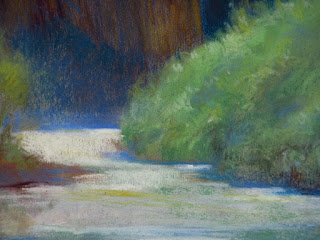 |
Passage 24x18 pastel
by Michael Chesley Johnson
|
The other day, I wrote about taking a pastel sketch made in the field and using it as a reference for a studio oil painting. This time, I want to address the reverse. Earlier this spring, I painted several small oil sketches at Zion National Park in Utah at a retreat I organized for some painters. One of the sketches really appealed to me, as I thought the moment it captured would make a stunning piece if painted much larger. The oil sketch was only 9x6 inches; my plan was to make it 24x18, and to do it in pastel.
 |
| Oil field study, 9x6 |
I felt the sketch would translate fairly easily into a larger size without the need for photo references for detail. So, I propped up the painting next to my easel and got to work. After the block in, and once I began to adjust color relationships, the "detail" began to appear automatically—all without my having to refer to a photo. Sometimes, the painting tells you what it needs, and also my experience in painting this kind of scene came into play.
I made the painting on a sheet of steel-grey Canson Mi-Teintes. For my pastels, I used NuPastels for 90% of the painting and then finished with Unisons. Because the Canson paper can only hold so much pastel, I used a little Lascaux fixative now and then to give the paper more "grip." Also, I used it more heavily wherever I needed to darken a passage. At the end, I used the sharp edge of a dark blue pastel to add three small ravens over the central cliff to help with the sense of scale. Here are some detail shots:
I painted the original small field sketch because I'd fallen in love with the shadowy blue that you see as you look down the length of the Virgin River in the early morning. I think I was able to preserve this beautiful blue in the larger pastel.
I put together a short video that shows some of the process, below. For those of you receiving this post via e-mail, you can see the video at this link





















